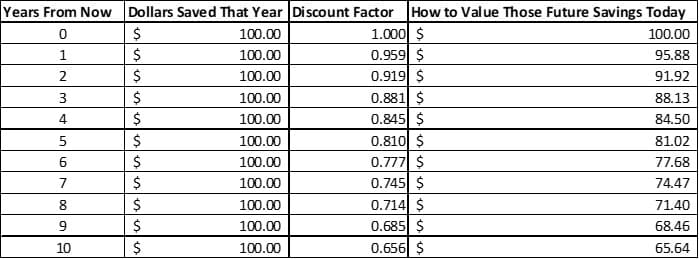I don’t usually dive into odd niche topics like this, but I just spent 12 hours car shopping over the weekend. That’s a lot of test drives and awkward conversations with over-enthusiastic salespeople. Sorry, Clayton, I can’t picture myself driving this car off the lot today…why do you ask?
Long story short, I’ve compared tons of cars recently. Hybrids, as you might know, are always more expensive than their all-gas counterparts. But…aren’t hybrids cheaper to operate? Which means…could they save us money in the long run?! This got my finance brain whirring to life.

I wrote an article in 2020 and updated it in 2023 that covers the real, total cost of car ownership. The cost of car ownership can be broken down into 6 main categories:
- Purchase/Depreciation
- Financing
- Maintenance and Repair
- Fuel
- Registration/Inspection
- Insurance
Financing rates, registration costs, and inspection costs are universal for all cars. There’s no difference between a traditional gas car and a hybrid on those axes.
But we know (or at least suspect) purchase costs, maintenance, fuel, and insurance costs will vary between hybrids and all-gas cars.
A Bird in the Hand…
Aesop wrote in 600 BC that “a bird in the hand is worth two in the bush.” Or, in modern terms, “I’d rather have a dollar in my hand today than two dollars in 20 years.”
Money today is worth more than money in the future. This is called discounting. And we’ve used this idea before to analyze mortgage costs.

We’re faced with a similar problem today.
When we buy a hybrid car, we spend more on the purchase price today. But, ostensibly, we save operating costs each year we own the vehicle. However, those future savings are worth less than the extra dollars spent today.
Do we save enough on long-term operating costs to compensate for the differences in sticker price and depreciation? That’s the question!
To answer it, we need to:
- Understand the differences in costs between gas cars and hybrids (sticker cost, depreciation, fuel costs, insurance costs, maintenance costs).
- Determine an appropriate discount rate for this analysis and apply it.
An Appropriate Discount Rate
As of 2022, the average age of all cars on American roads is 12.5 years. That said, the average car owner has their vehicle for 8 years before (most often) selling it or (less often) it breaks down completely.
Therefore, a happy medium duration for today’s analysis is 10 years. We’re going to look at the differences between hybrids and gas cars over a 10-year life.

How much less valuable is a dollar in 2034 than a dollar today?
Warren Buffett uses U.S. Treasury bond rates as his discount rate. I’m inclined to agree with him. It’s “the risk-free rate.” In any analysis, we can ask ourselves, “Would I rather pursue [this risky option], or simply invest my money in U.S. Treasury bonds for a decade or two?” Good enough for Warren, good enough for me.
As of February 2024, the 10-year Treasury rate is 4.3%. The table below shows how to apply that discount rate to future savings.

Example: I could take $74.47 today, invest it in a 4.3% annual interest bond, and I’d have $100.00 in seven years. Thus, if a hybrid car saves me $100 in 2031, it’s precisely the same as having $74.47 in my pocket today in 2024. A bird in the hand…
How Much Does a Hybrid Save Us?
We need an example of two cars to analyze. Since Kelly and I are currently active car market participants (we’re soon to have a “Baby on Board”…by the way, what’s the deal with those stickers?), I’ve been researching the Kia Sorento. Let’s dig into the details of the all-gas Sorento vs. the hybrid Sorento.
All these details I’m about to share with you are shown mathematically in this spreadsheet. Please feel free to make a copy and play around yourself.
To make a copy of a Google Sheet: File –> Make a Copy
Sticker Price and Depreciation Rate
The gas Sorento starts at $31,990. The hybrid Sorento starts at $36,990.
According to iSeeCars, both vehicles will depreciate 53% in their first 5 years.
Gas Expenses
To calculate estimated gas expenses, we need to understand:
- how far we drive
- our miles-per-gallon efficiency of the cars
- and the cost of gas
Depending on your source, the average American drives between 13,000 and 15,000 miles per year. We’ll use 14,000 miles per year for this article.
The Kia Sorento hybrid gets 35 miles per gallon (we’re looking at the all-wheel drive model, thanks to snowy Rochester winters). The all-gas Sorento gets 24 miles per gallon.

Average American gas prices are currently $3.27 per gallon.
We combine those numbers to find out:
- The Sorento Hybrid incurs $1308 of gas expenses per year.
- The all-gas Sorento incurs $1907 of gas expenses per year
Insurance Costs
The average “full coverage” auto policy costs $2000. Your miles may vary (#carjoke).
Insurance is very personal in that nature. Your driving history and desired coverage level significantly affect the insurance premium.
Nevertheless, we’ll use $2000 per year for the all-gas Sorento. Hybrid insurance costs, on average, 7% more than all-gas models; the Sorento Hybrid will cost $2140 per year.
Maintenance
Most sources cite that hybrid maintenance costs are lower than all-gas engines, as hybrids use regenerative braking (fewer brake replacements), don’t use alternators or starters, and tend to have simpler transmissions.
Unfortunately, I cannot find any sources that provide hard numbers to support this claim! If you find something, please let me know.
Therefore, I’m using an average figure of $600 per year for repairs and maintenance and biasing those dollars towards the end of the cars’ lives. Newer cars break down less and are covered by various levels of warranty.

All-In Costs: Hybrid vs. All Gas
Over our 10-year analysis period, the Kia Sorento Hybrid would cost us $55,662 (depreciation + gas + insurance + maintenance), as measured in 2024 dollars.
The all-gas model would cost us $56,491.
Pretty darn close, but it’s a slight nod to the hybrid model. Category-by-category, the results are:
- The hybrid costs $3000 more in depreciation costs.
- The hybrid saves $4997 in gasoline costs.
- The hybrid costs $1167 more in insurance.
And while I’m focusing only on dollars and cents here, there’s an environmental argument too. I won’t dive into the details. But you should probably place a value on environmental costs and benefits (albeit a difficult value to define in dollars and cents).

Of course, this is a perfect example of “average pilot syndrome.” Averages are useful in theory but rarely in practice. You must re-run this analysis for your unique scenario. The first questions that come to mind are:
- Which specific model are you looking into? It might not be the Kia Sorento.
- What are the miles per gallon ratios of the all-gas and hybrid models?
- What are insurance rates like? Not only for your preferred car, but for you?
- What are the typical maintenance costs of your desired car?
- How does your car depreciate over time?
- Should you adjust the discount rate? (PS – you can play around with the spreadsheet yourself, and you’ll see that the discount rate does not change the outcome significantly in this case.)
Was It Worth It?
We’ve covered a lot of conjecture and “what if” questions, made some assumptions, and created a spreadsheet. Is it all worth it?
First, I think I’m directionally accurate. Will the real world play out as I’ve modeled here? Of course not. For all I know, an asteroid will blast our car into smithereens on its first night in the garage (it’ll be a new kind of hybrid; half shrapnel, half vapor). But I think I have a better factual understanding now than I did before. I hope you agree.
This was ~2 hours of work (mainly on the writing, not the math) to optimize an $800 decision. And because I’ve discounted those future dollars, that’s $800 as measured today. Not bad! For some hybrids, this is likely to be a multi-thousand dollar difference. Nice!
Time to unplug, fill up, and peel out.
Thank you for reading! If you enjoyed this article, join 8000+ subscribers who read my 2-minute weekly email, where I send you links to the smartest financial content I find online every week.
-Jesse
Want to learn more about The Best Interest’s back story? Read here.
Looking for a great personal finance book, podcast, or other recommendation? Check out my favorites.
Was this post worth sharing? Click the buttons below to share!